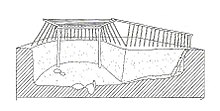Mogollon culture
The Mogollon culture is a prehistoric Indian culture in southwest North America , which, depending on the interpretation, lasted between 200 BC. It began until 250 AD and either became part of the Anasazi culture around 1400 or existed until the first appearance of the Spaniards around 1540. It emerged from the predecessors of the Archaic Period and took over the manufacture of ceramics and possibly also the oldest house types from the neighboring Hohokam culture, which began a little earlier . For their part, the Mogollon strongly influenced the subsequent Anasazi culture to the north. The majority of the Mogollon Indians believed to speak a Penuti language . First the Mogollon built pit houses , later detached houses made of stones and adobe bricks . From around the year 1000, they preferred building pueblos . In contrast to the Anasazi, the cult spaces called kiva were of secondary importance for the Mogollon .
The Mogollon developed a high level of agriculture with artificial irrigation and processing of crops. Other cultural products included a wide variety of tools, pottery, wickerwork and turquoise, stone and shell jewelry. They offered these goods for trade in large areas. It is believed that the Mogollon are ancestors of today's Pueblo culture .
Discovery and definition
The Mogollon culture was first defined in 1934 by HS Gladwin during excavations around the Gila Cliff Dwellings and scientifically described in 1936 by Emil W. Haury. He used the combination of pit houses and two typical ceramic styles to separate them from cultures that were adjacent in time and space. Joe Ben Wheat introduced a five-period classification of the Mogollon culture in 1955.
The culture is named after the Mogollon Mountains , in which the first finds were made and for which the Spanish governor Nuevo Mexicos from 1712 to 1715, Juan Ignacio Flores Mogollón, was named.
timeline
| time | epoch | description |
|---|---|---|
| 300 AD to 650 AD | Mogollon I | early pithouse period |
| A.D. 650 to A.D. 850 | Mogollon II | Pithouse period |
| 850 AD to 1000 AD | Mogollon III | Jacals period |
| 1000 AD to 1150 AD | Mogollon IV | Classic period |
| 1150 AD to 1450 AD | Mogollon V | Splitting into Casas Grandes, Mimbre (Cibola), Salado groups |
Settlement area
The settlement area of the Mogollon is predominantly in the south of the US states Arizona and New Mexico . It is bounded by the Little Colorado River to the north, the Verde River to the west, and the Pecos River to the east. The southern border is not sharply defined, the area of influence extended to Texas and today's Mexico in the mountain and desert region in the west of Chihuahua and some areas in the east of Sonora . The region as a whole is a rugged highland that was loosely forested despite the dry climate. In the area, the mountain ranges and plateaus were predominantly populated, the lower-lying deserts and semi-deserts were hardly used.
The Mogollon culture is divided regionally according to river systems. The Mimbres (in the valley of the Mimbres River ) and the Pine Lawn or Cibola Mogollon (in the valley of the San Francisco River ) in New Mexico, the Point of Pines ( Black River ), and San Simon ( San Simon River ) are delimited ) and Forestdale-Mogollon ( Forestdale Creek ) in Arizona.
The Jornada-Mogollon are named after the Jornada del Muerto ( Route of Death ), along which the most important settlements of this subgroup were excavated. They settled in the south and east of the entire area in an arc from El Paso over Texas and in New Mexico almost to Albuquerque . As inhabitants of the lowlands, they lived much longer and to a greater extent as hunter-gatherers and developed different agricultural methods, ceramic styles and construction forms for huts and underground storage facilities. They are therefore considered to be a relatively distantly related culture. An analysis of ceramic styles and rock art showed that they had a close cultural connection with the Paquimé (also Casas Grandes ), who lived about 250 to 300 km south . Material goods were not exchanged on a large scale, however, both cultures obtained obsidian from completely separate sites, although this cannot be justified by the pure distance between the source and the place of discovery.
literature
- Mogollon Culture Area. In: Guy Gibbon: Archeology of Prehistoric Native America . Taylor & Francis, 1998, ISBN 0-8153-0725-X , p. 536 ff.
- Helmut von Papen : Pueblos and Kivas; The story of the ANASAZI and its neighbors. 2000, ISBN 3-00-006869-4 .
- Wolfgang Haberland: American archeology . Scientific Book Society, Darmstadt 1991, ISBN 3-534-07839-X .
Web links
Individual evidence
- ^ Sean G. Dolan, Myles R. Miller, M. Steven Shackley & Kristin Corl: El Paso Phase Obsidian Procurement in Southern New Mexico: Implications for Jornada Mogollon Regional Interaction and Exchange . In: Kiva - The Journal of Southwestern Anthropology and History, Volume 83, Number 3 (September 2017), pp. 249-266. DOI: 10.1080 / 00231940.2017.1320064


